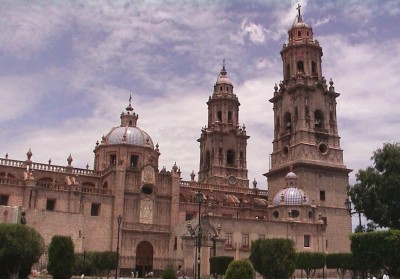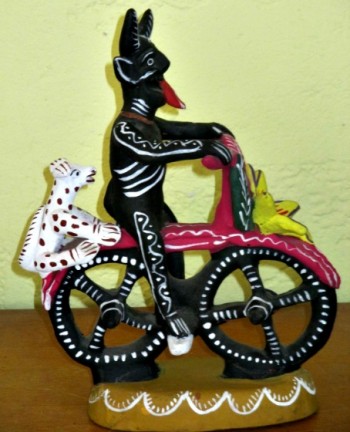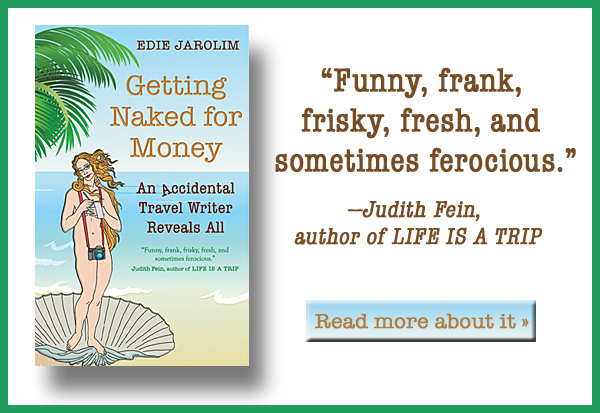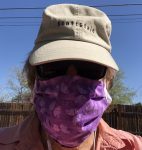Mexico’s Sweet Spot
Don’t be put off by the bees. Yes, there’s definitely a buzz at Morelia’s candy market, but not of the Hollywood celebrity sort. The bees are visiting the Mercado de Dulces for the same reason you are: to sample sesame bars, glazed papaya slices, bread pudding, and other Mexican sweets. Unless you’ve dabbed on eau de caramel, you’re not going to enter their radar.
I’m on my second visit to Morelia, the bustling capital of central Mexico’s state of Michoacan. On a quick stopover a few months earlier, I’d been intrigued by my glimpses of the soaring cathedral, serpentine aqueduct, and other architectural treasures that earned downtown Morelia its UNESCO World Heritage Site status. But all the museums were shuttered that late Sunday afternoon and — I admit it — I was afraid to venture into the candy market because of the bees.
This time, I’ve set aside a day and a half for exploring. After a quick sweet roll and coffee at my hotel, I cross the sprawling Plaza de Armas to the cathedral, a Mexican baroque confection made of cantera, the local pink limestone that lends downtown its rosy glow. I amble past pews of black shawled and business-suited parishioners in the airy main chapel, pausing to gape at devotional items like the gleaming silver baptismal font. I’m particularly riveted by a gargantuan pipe organ — made in 18th-century Germany of 6,400 pipes, according to the leader of the British tour group I sidle over to with fake nonchalance. Organmaster Alfonso Vega has been presiding for more than 40 years over the internationally famed organ festival held here every May.
From the cathedral, I stride east past storefronts sporting brightly colored fabrics and notions to the former convent behind the San Francisco church that hosts the Casa de Artesenias. I climb a worn stone staircase to the small monks’ cells where craftspeople from all over Michoacan demonstrate their skills, stopping briefly to watch a flamenco guitar being strung before planting myself, fascinated, in front of a weathered man from Tócuaro who is carefully sanding a large wooden devil’s mask. Several finished samples, painted blood red and black, sit propped behind him. The maskmaker explains they’re for La Candelaria, a February festival where devils rampage merrily around town before being booted out by the angel Gabriel and other heavenly party poopers.
I’m tempted to buy one of the masks from him, but they’re too large to be taken home easily. Instead, I head downstairs to a series of bright, modern rooms where crafts are arrayed on open displays labeled by town. Eventually, I select a small ceramic devil straddling a motorcycle with his dog — not nearly as scary as the satanic visages upstairs and far easier to stuff into a suitcase.
There’s nothing like a bit of acquisition to spur the appetite — for food and for more shopping. Fortunately, I can satisfy both urges at La Casa del Portal, back near the cathedral. According to his wife, Cecilia, who gives me a tour, furniture-maker Victor Alanis originally bought this three-story 16th-century home to serve as a studio and showroom. “Then he decided to sell the work of his friends and antiques that he liked and, next thing you know, we opened a restaurant,” she says. “It was so successful, we just finished putting in a rooftop bar.” Everything you see in the eclectic-chic dining rooms and overstuffed galleries flanking them is for sale.
Taking advantage of the balmy December day, I decide to dine on the rooftop patio, looking out over the cathedral’s twin spires. Because agricultural Michoacan is known for its maize, I order corundas, similar to tamales but triangular and steamed in the lower leaves of the corn plant rather than the husks. Here they’re topped with a delicately spiced tomato sauce. While eating, I eye lacquered chairs painted with intricate landscapes and dishes boldly patterned with suns and moons but, sadly, nothing seems easily transportable. I buy a chunky silver bracelet before I leave.
Thus fortified, I’m ready to resume sightseeing. Strolling east again under the portales shading Avenida Madero, where outdoor cafes hum with families and work shirkers, I soon reach the Palacio de Gobierno, an18th-century neoclassical building that once served as the executive seat. Now it’s known for the central balcony’s vivid depictions of Michoacan history by revered Morelia resident Alfredo Zalce, a student of Diego Rivera and, at 95, the last of the great Mexican muralists. Gazing up at the powerful image of a loincloth-clad Indian peasant bound with ropes, I remember why Rivera lost his commission to decorate Rockefeller Plaza.
Learning more about an earlier Morelia icon — in fact, the city’s namesake — is my next goal. I walk south to the quiet residential neighborhood where, in Casa Natal Morelos, yet another graceful neoclassical building, Jose Maria Morelos was born — though not, I learn, in a bed. Morelos’s mother was out shopping when she went into labor and couldn’t make it back to her own house, so the revolutionary hero entered the world in a neighborbor’s vestibule. The site of Mama Morelos’s embarrassment is marked with a plaque and flags.
After a short room rest, I grab a cab to San Miguelito, on the city’s modern south side. I’ve heard at my hotel that the house specialty steak, pounded thin and cooked with lemon, is tasty — and that I should check out the restaurant’s “special room.” I wander beyond a bar designed to look like a bullring and through two casual elegant dining rooms into a small space where nearly 250 images of Saint Anthony — made out of everything from corn husks to silver, and ranging from about ½ inch to 2½ feet high — hang upside down. San Miguelito owner Cynthia Martinez explains, “Saint Anthony is the patron saint of single women. If you pray to him, he’ll bring you a husband.” She laughs, “My father started collecting these saints for me, before I got married.” Why is he upside down, I wonder? To pressure him to act quickly, of course.
At lunch, Cecilia Alanis had mentioned that, of the many live music clubs springing up near La Casa del Portal, the oldest but still liveliest is La PeΖa del Colíbri. “It may look closed,” she’d warned, “but just knock on the narrow wooden door.” Having looked forward to a speakeasy-style adventure after dinner, I am now disappointed to find the nightclub’s door flung wide open. Nevertheless, I edge through a narrow corridor into a dimly lit, cavernous room and sit down at a long table. After several tequilas chased by sangrita, a spicy tomato juice mix, I join the chorus of locals singing along with the baritone folk guitarist; I think we’re calling for a revolution, but I’m not entirely certain. It also seems to me that the lifesize Day of the Dead figures behind the stage are moving to the rhythms of the young neuvo flamenco trio who come on next, but I can’t get anyone at my table to verify this.
I’m so taken with Morelia by now that, next morning, I’m ready to brave the candy market bees. Sure enough, half an hour later, I’m in sugar shock but completely stinger free. I feel a rush of ardor for a city that has a market devoted to sweets, a one-stop folk art shopping center, restaurants that dish out crafts and topsy-turvy romance, offbeat live music venues — plus abundant cultural monuments you can claim as your reason for visiting. Guilty pleasures and a good cover story: Morelia is my kind of town.
Originally published in National Geographic Traveler.











